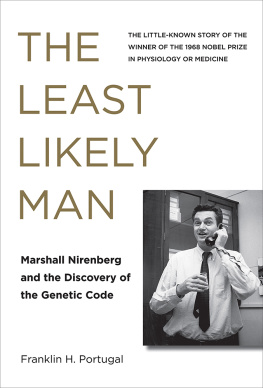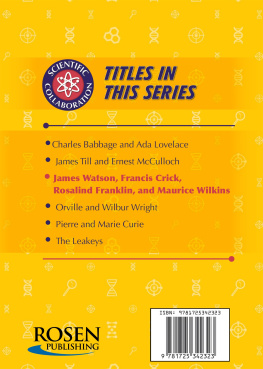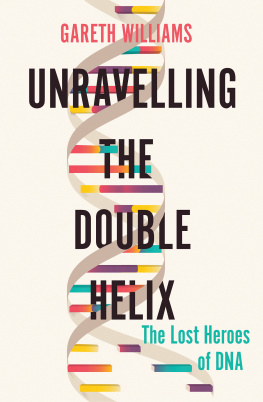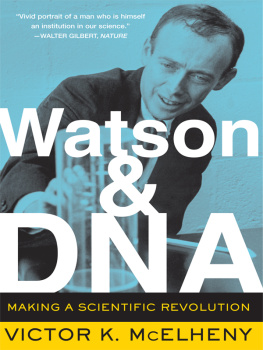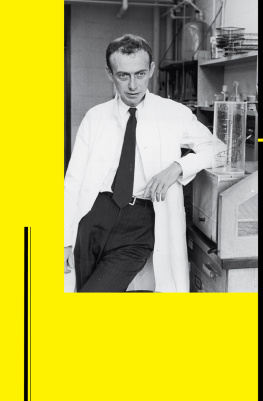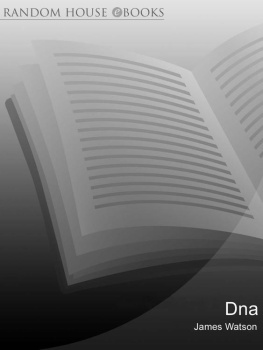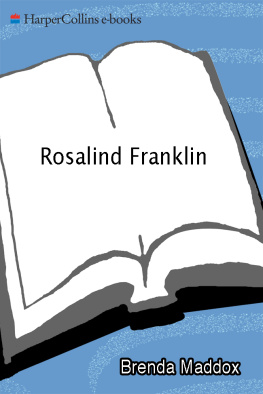
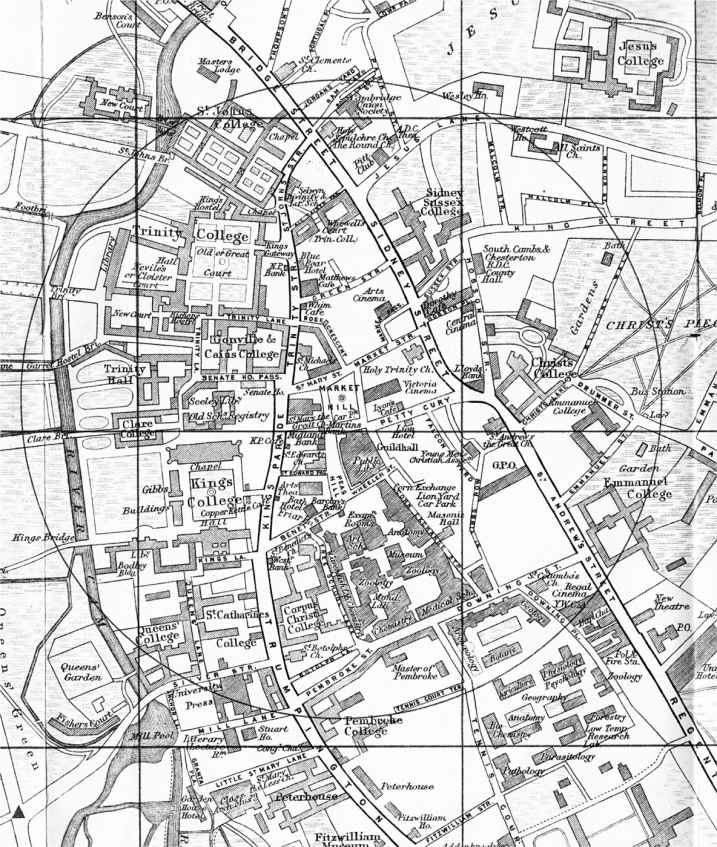
Cambridge city center, early 1950s. Detail of a map published by W. Heffer & Sons.
Thank you for purchasing this Simon & Schuster eBook.
Join our mailing list and get updates on new releases, deals, bonus content and other great books from Simon & Schuster.
C LICK H ERE T O S IGN U P
or visit us online to sign up at
eBookNews.SimonandSchuster.com

Contents
For Naomi Mitchison

Preface to Annotated and Illustrated Edition
I n Cold Spring Harbors Blackford Bar, one evening in June 2010, Sydney Brenner suggested looking through the papers he had recently donated to the Cold Spring Harbor Laboratory Archives. Among his own papers were, he knew, some of Francis Cricks correspondence that had become muddled in with his during the 20 years they had shared an office in Cambridge. A few days later we discovered that the trove included letters to and from Crick written during the period when he and Jim Watson at Cambridge, and Maurice Wilkins and Rosalind Franklin in London, were searching for the structure of DNA.
Mislaid some 50 years earlier (thrown out by an over efficient secretary, Crick believed), these letters had escaped the attention of the historians of molecular biology who first started looking into this new field in the mid-1960s. The letters provided some new insights into the proceedings, and in particular the personal relationships of the protagonists in the DNA story.
The most celebrated account of that story is The Double Helix , Watsons novelistic version of the events as they appeared to a 23-year-old American in Cambridge in the early 1950s. Written not in the tone of a formal autobiography nor in the measured language of the historian, his racy and thrillerlike telling was reviled by some and praised by many upon publication in 1968.
In writing our article on the lost Crick correspondence, we naturally reread The Double Helix . We were struck by how Watsons account in the book accurately represented the vivid, contemporary descriptions of people and events found in the letters, and not just those of Crick and Wilkins, but Watsons own. The social whirl of parties, tennis, French lessons, holidays, and other events that featured prominently in the bookthe gossip, as Crick characterized itwere recorded in the weekly letters Watson wrote to his sister Elizabeth during his time in Cambridge. And the science covered in the book was also discussed in contemporary letters to Max Delbrck and other friends, and not just the DNA work, but Watsons research on bacterial genetics and tobacco mosaic virus, projects that figure prominently in the story. In all of this contemporary correspondence, the character of Watson himselfthe brash, self-confident yet at times also self-deprecating, young man portrayed in his bookwas transparent. We became intrigued to see all the contemporary accounts we could findnot just those revealed in the letters of Watson, Crick, and Wilkins, but of Franklin, Linus Pauling, and others as well.
We also noticed just how many other characters appear in The Double Helix many unrelated to the central scientific story. Watson, eager to keep the narrative moving, often provides only the briefest of information, sometimes not even identifying the most intriguing of minor characters. We dont get to learn the interesting story of the local doctor who had rowing oars mounted on the wall of his surgery, or the identity of the antiquarian architect who kept his house free of gas and electricityor anything much about Bertrand Fourcade except that he was the most beautiful male in Cambridge. And what was the novel of ill-judged sexual indiscretions of Cambridge dons that Watson reads at one point in the story? We wanted to know.
And so the idea of an annotated edition of The Double Helix took shape, a version in which an array of viewpoints and voices would be added as commentary, together with background information and illustrations to enrich the text. The current volume is the result. In addition to the numerous photographs (a number being published for the first time), we have reproduced many letters and other documents in full or in part as facsimiles. One of the pleasures of visiting archives is to see and handle original documents and while we cannot match that experience, we hope that readers will enjoy seeing letters and manuscripts as their original recipients saw them.
The sources of material used in our annotations are many, both published and unpublished. Of the former, we used many booksincluding the histories and biographies of the field. These are listed in the bibliography at the end of the book. Among unpublished sources, Watsons letters to his sister and also his parents are a major source of information about his Cambridge life and have not been used before, except by Watson, while his letters to Delbrck, Luria, and others provide scientific content. In addition to Watsons papers, we have drawn on those of Crick, Wilkins, Pauling, and Franklin among others. We have also included reminiscences written by Ray Gosling specially for this edition. Gosling worked with both Wilkins and Franklin in those years and actually took the most famous and influential diffraction pictures of DNA. The source for each annotation is included in a reference list at the back of the book.
In addition to the annotations and illustrations, we have added a number of other pieces. We have included Watsons account of winning the Nobel Prize, previously published in his later book, Avoid Boring People . This seems, on the occasion of the 50th anniversary of that award, a fitting conclusion to the tale. We have also added five appendices. These include one in which we reproduce facsimiles of the first letters Watson and Crick each wrote in 1953 describing the discovery, and another in which we publish for the first time a chapter from the draft manuscript of The Double Helix which was left out of the published book. While not describing anything new about the work on DNA, the missing chapter fills in the story of Watsons summer spent in the Alps in 1952.
We have corrected some errors of fact by adding annotations where necessary, but Watsons original text is unchanged.
It will be clear that this edition is not an exhaustive academic treatise. Rather, we chose items that appealed to us and hope that this somewhat quirky selection will prove useful and enjoyable to both new readers and those familiar with the original text.
Alexander Gann
Jan Witkowski
Cold Spring Harbor 2012
Sir Lawrence Braggs Foreword to the Original Edition
T his account of the events which led to the solution of the structure of DNA, the fundamental genetical material, is unique in several ways. I was much pleased when Watson asked me to write the foreword.
There is in the first place its scientific interest. The discovery of the structure by Crick and Watson, with all its biological implications, has been one of the major scientific events of this century. The number of researches which it has inspired is amazing; it has caused an explosion in biochemistry which has transformed the science. I have been amongst those who have pressed the author to write his recollections while they are still fresh in his mind, knowing how important they would be as a contribution to the history of science. The result has exceeded expectation. The latter chapters, in which the birth of the new idea is described so vividly, are drama of the highest order; the tension mounts and mounts towards the final climax. I do not know of any other instance where one is able to share so intimately in the researchers struggles and doubts and final triumph.
Next page

